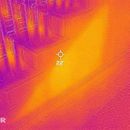Heat (170°f) in unused space under stairs?
When we built your new house the HVAC contractor ran tube for lower level in-slab heat in an unused space below our stairs (as well as a closet under the stairs that wasn’t supposed to be heated). And then didn’t run it in the hall space next to the stairs that was supposed to be heated. The unused enclosed space (below) has gotten to as much as 170°f. The closet to around 110°f.
Any idea if that area getting to 170°f is likely to damage anything? I’m thinking likely not and just ignore it.
Thanks,
GBA Detail Library
A collection of one thousand construction details organized by climate and house part










Replies
I think you should get an artist to paint a realistic fireplace on the wall there and the family can gather around it on cold winter evenings.
But seriously, you are saying that there's there's tubing embedded in the slab under there, not that tubing is routed through there above the slab? Either way, I'm puzzled by it getting to 170 F. It's rare to to use water hotter than 140 F, and you would expect that space to only get partway up to the water temperature. If it's 170 in the space, it seems like the water must be 190 or so, which seems like maybe a problem with the controls on the boiler.
And 170 in the space seems hot enough that you'd severely dry out the wood nearby, and get a lot of seasonal movement, gradually making things get a little out of whack. And you are limited in what you can safely store in the closet.
That's bonkers: in-slab tubing uses water ~100 degrees, often less. The contractor needs to fix the system, that water is too hot. What kind of boiler do you have?
That's awfully hot. Electrical wire ratings assume an ambient temperature of 86*F, above which you have to derate the wire. Most other electrical things are rated for a maximum ambient temperature of 104*F. For some perspective here, typical NM wire is rated for 60*C, which is 140*F, which is the hottest it's supposed to be, ever! The highest rated wire insulation used for normal building wire is rated for 90*C, which is 194*F, and you are dangerously close to that.
The short of that is you have a problem here, and it's something that needs to be addressed NOW. You are not just at risk of wierd problems with thermal expansion of the structure, you're up over rated allowable temperatures for a lot of the other materials used in the construction of your home (PVC pipe is only rated for 140*F too).
They're probably running that system with too-hot water, and they probably haven't insulated the lines in that area sufficiently, either. Get your contractor to fix the problem, and get them to do it NOW.
I would also double check with a regular thermometer, just as a sanity check against your thermal imager being less than accurate here.
Bill
If there are sprinklers that would be hot enough to set them off.
22 Celcius (as shown in picture) is about 71 F. Not 170 F.
Thanks all. Very true about boilers usually being about 140°f. I'll double check the temps on the boiler and what I was seeing in that space. Could there have been something radiant in there causing the higher temps? I was using a Thermoworks PTFE K probe (https://www.thermoworks.com/prb-k-37x-t/) that I think should be somewhat immune to radiant.
There is a bit of romex running through that space. No sprinklers.
The 22°c shown on the image is the surface of the trim board - simply the default location w/ the FLIR-ONE. I'll have to go in to the FLIR app to see what the surface temp of the drywall here was.
The probe you were using is a thermocouple type, those are usually pretty reliable. If that's what read 170*F, and it was in the ambient air, then you definetely have a problem in there -- things should NOT be that hot.
Bill